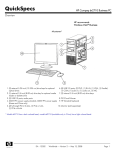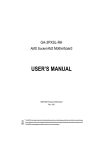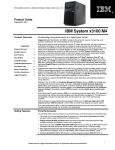Download USER'S MANUAL
Transcript
GA-6QPCV-RH Intel® mini-ITX Motherboard USER’S MANUAL Intel® mini-ITX Motherboard Rev. 1001 * The WEEE marking on the product indicates this product must not be disposed of with user's other household waste and must be handed over to a designated collection point for the recycling of waste electrical and electronic equipment!! * The WEEE marking applies only in European Union's member states. Copyright © 2007 GIGA-BYTE TECHNOLOGY CO., LTD. All rights reserved. The trademarks mentioned in the manual are legally registered to their respective companies. Notice The written content provided with this product is the property of Gigabyte. No part of this manual may be reproduced, copied, translated, or transmitted in any form or by any means without Gigabyte's prior written permission. Specifications and features are subject to change without prior notice. Product Manual Classification In order to assist in the use of this product, Gigabyte has categorized the user manual in the following: For detailed product information and specifications, please carefully read the "Product User Manual". For detailed information related to Gigabyte's unique features, please go to "Technology Guide" section on Gigabyte's website to read or download the information you need. For more product details, please click onto Gigabyte's website at www.gigabyte.com.tw GA-6QPCV-RH Motherboard Table of Contents Item Checklist ........................................................................................ 4 Chapter 1 Introduction ............................................................................ 5 1-1 Considerations Prior to Installation ....................................................... 5 1.2 Features Summary ................................................................................ 8 1.3 Motherboard Components .................................................................. 10 Chapter 2 Hardware Installation Process ............................................. 11 2-1: Installing Processor ............................................................................ 11 2-2: Installing Processor Colling Fan ........................................................ 12 2-3: Install Memory Modules ..................................................................... 13 2-4: Connect ribbon cables, cabinet wires, and power supply ................ 15 2-4-1 : I/O Back Panel Introduction ................................................................................ 15 2-5: Connectors Introduction & Jumper Setting ........................................ 20 2-6: Block Diagram ................................................................................... 33 Chapter 3 BIOS Setup .......................................................................... 34 Main ........................................................................................................... 36 Advanced ................................................................................................... 39 System Management ...................................................................................................... 40 CPU Control Sub-Menu .................................................................................................. 41 Video (Intel IGD) Control Sub-Menu ............................................................................... 43 ICH Control Sub-Menu .................................................................................................... 46 Super I/O Sub-Menu ....................................................................................................... 48 Power Feature Sub-Menu .............................................................................................. 50 AMT Sub-Menu ............................................................................................................... 52 Hardware Monitor ............................................................................................................ 55 Security ...................................................................................................... 57 Boot ............................................................................................................ 59 Exit ............................................................................................................. 60 3 Introduction Item Checklist The GA-6QPCV-RH motherboard Serial ATA cable x 2 I/O Shield Kit HDD Power (SATA & 4P) cable x 2 CD for motherboard driver & utility GA-6QPCV-RH Quick Reference Guide * The items listed above are for reference only, and are subject to change without notice. 4 GA-6QPCV-RH Motherboard Chapter 1 Introduction 1-1 Considerations Prior to Installation Preparing Your Computer The motherboard contains numerous delicate electronic circuits and components which can become damaged as a result of electrostatic discharge (ESD). Thus, prior to installation, please follow the instructions below: 1. Please turn off the computer and unplug its power cord. 2. When handling the motherboard, avoid touching any metal leads or connectors. 3. It is best to wear an electrostatic discharge (ESD) cuff when handling electronic components (CPU, RAM). 4. Prior to installing the electronic components, please have these items on top of an antistatic pad or within a electrostatic shielding container. 5. Please verify that the power supply is switched off before unplugging the power supply connector from the motherboard. Installation Notices 1. Prior to installation, please do not remove the stickers on the motherboard. These stickers are required for warranty validation. 2. Prior to the installation of the motherboard or any hardware, please first carefully read the information in the provided manual. 3. Before using the product, please verify that all cables and power connectors are connected. 4. To prevent damage to the motherboard, please do not allow screws to come in contact with the motherboard circuit or its components. 5. Please make sure there are no leftover screws or metal components placed on the motherboard or within the computer casing. 6. Please do not place the computer system on an uneven surface. 7. Turning on the computer power during the installation process can lead to damage to system components as well as physical harm to the user. 8. If you are uncertain about any installation steps or have a problem related to the use of the product, please consult a certified computer technician. Instances of Non-Warranty 1. 2. 3. 4. 5. 6. Damage due to natural disaster, accident or human cause. Damage as a result of violating the conditions recommended in the user manual. Damage due to improper installation. Damage due to use of uncertified components. Damage due to use exceeding the permitted parameters. Product determined to be an unofficial Gigabyte product. 5 Introduction Additional Notices 1. Flash SPI ROM Update BIOS & ME need in accordance with the worksheet (Please see the illustrated table below:) Checklist The table provides a summarized checklist of principal steps requires to bring up a Intel ® AMT firmware release on CRB platform, arranged in the sequence that they should be performed. Please use the checklist to ensure no steps were missed. Build FW Image using FIT (Flash image tool) Set optimal defaults in system BIOS Shut down disable Intel® ME by closing the Manufacturing Mode jumper or removing all memory modules from Bank0 Program the image onto the SPI Flash using the FPR tool Verify the image (fpt/v) Shut down, do a clear CMOS using jumper J5H2 Restart the system to boot BIOS from the Flash Enter BIOS setup and enable Intel ® TPM and Intel® AMT (through Security menu-> TPM) Do a full G3 reset (disconnect power cable for 10 seconds) Restart the system and use CTRL-P to enter MEBx Set desired Intel ® ME and Intel® AMT settings Restart the system and begin Intel® AMT & Intel® TPM testing Install OS 2. Recommanded CPU Cooler APR Vender: Cooler Master Vender cooler P/N:GECC-00633-01-GP/ECC-00633-01-GP 3. GA-6QPCV-RH 90W Adpater Max Support I. 2.5” HDD *4 II. 3.5” HDD * 2 6 GA-6QPCV-RH Motherboard 4. Suggested to blow the wind generated by system fan to the DC convertor near CPU. (Please see the marked location below:) 7 Introduction 1.2 Features Summary Form Factor CPU y y 170mm x 170mm Mini ITX form factor, 8 layers PCB. Supports single Intel® Merom/Penryn/Celeron M585/M575 y series processor Socket P with 667/800/1066MHz Chipset y y Intel® GM45 MCH Intel® ICH9M-E Memory y y 2 x DDR2 SO-DIMM sockets Supports up to 4GB 667/800 memory y y Supports 1.8V DDR2 SO-DIMMs ITE IT8718F Super I/O Expansion Slots y y Supports 1 PCI slots 32-Bit/33MHz Supports 1 mini card slot (PCI-E x1/ USB 2.0) SATA Controller y y Built in Intel® Matrix RAID 0,1 Supports 4 SATA connectors On-Board Graphic y y Intel® GMA 4500MHD Graphic Engine Shared system memory up to 378MB Internal Connector y y 1 x 19V_IN DC power connector 4 x SATA connectors y y 2 x Serial connectors (COM) 1 x front audio connector y y 3 x USB 2.0 connectors for additional 6 ports by cable 1 x front panel connecctor y y 1 x System fan cable connector 1 x CPU fan cable connector y y 2 x SPDIF Out (Optical + Coaxial) 1 x YPbPr prot (HDTV out ) y y 1 x HDMI prot 1 x VGA port y y 4 x USB 2.0 ports 2 x LAN RJ45 ports y 1 HD Audio jacks (Line-out / MIC-in / Line-in/Cen/SURR) can configure 7.1 channel output by utility y Enhanced features with CPU Vcore, 1.8V reference, 3.3V, 5V, 12V, CPU Temperature, and System Temperature I/O Control Rear Panel I/O Hardware Monitor 8 GA-6QPCV-RH Motherboard y values viewing CPU/Power/System Fan Revolution Detect On-Board LAN y y CPU shutdown when overheat Intel® 82567LM and 82574L GbE controllers BIOS y y Supports WOL, PXE Phoenix BIOS on 16Mb x 2 SPI Flash ROM y y External Modem wake up Supports S1, S3, S4, S5 under Windows Operating System y y Wake on LAN (WOL) Supports IAMT 4.0 y Supports 3-pin system fan controller Additional Features 9 Introduction 1.3 Motherboard Components PS/2 USB & LAN Intel 82574L Intel GM45 DDR 2 PCI 32/33MHz Intel ICH9M-E SPDIF YPbPr DDR 1 LVDS_CTL1 Intel 82567LM HDMI VGA LVDS (Slave) F_Audio USB & LAN LVDS (Master) Audio jack DC Power Jack F_USB1 SATA3 SATA2 SATA4 SATA1 CPU F_USB2 F_USB3 CPU_FAN F_Panel PWR1 PWR2 10 SYS_FAN ITE IT8718F Battery Mini PCI-E COM1 COM2 GA-6QPCV-RH Motherboard Chapter 2 Hardware Installation Process 2-1: Installing Processor Step 1 The processor socket come with a screw to secure the processor. Insert the CPU into the socket by making sure the notch on the corner of the CPUcorresponds with the notch on the inside of the socket. Step 2 Once the processor has slide into the socket, lock the screw. Refer to the figures below. 1 2 Lock Unlock 11 Hardware Installation Process 2-2: Installing Processor Colling Fan ! WARNING! To prevent the CPU overheat, please make sure you have apply the CPU cooler paste on the surface of installed CPU Step 1 Attach the heat sink n the procssor socket. Secure the cooing fan with screws. Step 2 Connect processor fan can cable to the processor fan connector. 1 1 1 2 12 GA-6QPCV-RH Motherboard 2-3: Install Memory Modules Before installing the memory modules, please comply with the following conditions: 1. Please make sure the computer power is switched off before installing or removing memory modules. The motherboard supports DDR2 memory module, whereby BIOS will automatically detect memory capacity and specifications. The memory module only can be inserted in one direction. Installation Steps: Step 1. Unlock a SO-DIMM socket by pressing the retaining clips outwards. Aling a SO-DIMM on the socket such that the notch on the SO-DIMM exactly match the notch in the socket. Step 2. Firmly insert the SO-DIMMinto the socket until the retaining clips snap back in place. Reverse the installation steps if you want to remove the SO-DIMM module. 13 Hardware Installation Process Table 1. Supported DIMM Module Type Size 512MB 1GB 2GB Organization 16MB x 8 x 8bks 32MB x 16 x 8bks 32MB x 8 x 8bks 64MB x 16 x 8bks 32MB x 8 x 8bks 64MB x 16 x 8bks RAM Chips/DIMM 8 16 8 16 8 16 14 GA-6QPCV-RH Motherboard 2-4: Connect ribbon cables, cabinet wires, and power supply 2-4-1 : I/O Back Panel Introduction 15 Hardware Installation Process DC Power Jack Connect the DC power to this port. / / YPbPr Ports The "Y," "Pb" and "Pr" are sets of three inputs or outputs on better video equipment and TVs. Blue port represents Pb port, Red represnts Pr port, and Green represent Y port. Connect the YPbPr cable to these three ports. SPDIF Out (COAXIAL) The SPDIF coaxial output port is capable for providing digital audio to external speakers or compressed AC3 data to an external Dolby Digital Decoder via a coaxial cable. VGA Port Connect the monitor cable to this port. HDMI Port The HDMI (High-Definition Multimedia Interface) provides an all-digital audio/video interface to transmit the uncompressed audio/video signals and is HDCP compliant. Connect the HDMI audio/video device to this port. The HDMI Technology can support a maximum resolution of 1920x1080p but the actual resolutions supported depend on the monitor being used. NOTE: After installing the HDMI device, make sure the default device for sound playback is the HDMI device. (The item name may differ by operating system. Refer the figures below for details.), and enter BIOS Setup, then set Onboard VGA output connect to D-SUB/ HDMI under Advanced BIOS Features. Please note the HDMI audio output only supports AC3, DTS and 2-channel-LPCM formats. (AC3 and DTS require the use of an external decoder for decoding.) In Windows XP, select Start>Control Panel>Sounds and Audio Devices>Audio, set the Default device for sound playback to Realtek HDA HDMI Out. 16 GA-6QPCV-RH Motherboard In Windows Vista, select Start>Control Panel>Sound, select Realtek HDMI Output and then click Set Default. PS/2 Keyboard and PS/2 Mouse Connector This port can be installed a PS/2 keyboard or mouse device. LAN Port The LAN port provides Internet connection of Gigabit Ethernet with data transfer speeds of 17 Hardware Installation Process 10/100/1000Mbps. USB Before you connect your device(s) into USB connector(s), please make sure your device(s) such as USB keyboard, mouse, scanner, zip, speaker...etc. have a standard USB interface. Also make sure your OS supports USB controller. If your OS does not support USB controller, please contact OS vendor for possible patch or driver updated. For more information please contact your OS or device(s) vendors. Line In The default Line In jack. Devices like CD-ROM, walkman etc. can be connected to Line In jack. Line Out (Front Speaker Out) The default Line Out (Front Speaker Out) jack. Stereo speakers, earphone or front surround speakers can be connected to Line Out (Front Speaker Out) jack. MIC In The default MIC In jack. Microphone must be connected to MIC In jack. Center Speaker Out (Rear Speaker Out) The default Center Speaker Out (Rear Speaker Out) jack. Rear center speakers can be connected to Center Speaker Out (Rear Speaker Out) jack. Surround/Subwoofer Speaker Out The default Surround/Subwoofer Speaker Out jack. Surround/Subwoofer speakers can be connected to Surround/Subwoofer Speaker Out jack. SPDIF Out (OPTICAL) The SPDIF optical output port is capable for providing digital audio to external speakers or compressed AC3 data to an external Dolby Digital Decoder via an optical cable. 18 GA-6QPCV-RH Motherboard LAN LED Description LED2 (Green/Yellow) LED1 (Green) Name Color Condition Description LED1 Green Green ON BLINK LAN Link / no Access LAN Access - OFF OFF Idle 10Mbps connection Green OFF ON Port identification with 10 Mbps connection 100Mbps connection Green Yellow BLINK ON Port identification with 100Mbps connection 1Gbps connection Yellow BLINK Port identification with 1Gbps connection LED2 19 Connector Introduction 2-5: Connectors Introduction & Jumper Setting 20 23 18 24 25 5 6 10 11 21 22 26 14 7 15 8 3 4 9 13 2 1 12 16 17 19 1. SATA1 (SATA cable connector) 2. SATA2 (SATA cable connector) 3. SATA3 (SATA cable connector) 4. SATA4 (SATA cable connector) 5. COM1 6. COM2 7. F_USB1 (Fornt USB cable connector) 8. F_USB2 (Fornt USB cable connector) 9. F_USB3 (Fornt USB cable connector) 10. LVDS connector (Master) 11. LVDS connector (Slave) 12. CPU_FAN1 13. SYS_FAN1 20 14. PWR1 15. PWR2 16. F_Panel (Front Panel connector) 17. WLAN_LED1 18. LVDS_CTL1 19. BAT1 (Battery) 20. F_AUDIO1 21. COMS2 (Power COM select) 22. COMS1 (Power COM select) 23. LVDS_PSEL2 24. CLR_ME1 25. BIOS_RE1 26. CLR_CMOS (Clear CMOS) GA-6QPCV-RH Motherboard 1/ 2/ 3/ 4 ) SATA 1~4 (Serial ATA cable connectors) SATA 3Gb/s can provide up to 300MB/s stransfer rate. Please refer to the BIOS setting for the SATA 3Gb/s and install the proper driver in order to work properly. 1 7 Pin No. 1 2 3 4 5 6 7 SATA3 SATA2 SATA4 SATA1 Definition GND TXP TXN GND RXN RXP GND 5/ 6 ) COM1/COM2 COM1 9 1 10 2 Pin No. 1 2 3 4 5 6 7 8 9 10 COM2 21 Definition DCDSIN2 SOUT2 DTR2GND DSR2RTS2CTS2RI2NC Connector Introduction 7/ 8/ 9 ) F_USB1/2/3 (Front USB cable connectors) Be careful with the polarity of the front USB connector. Check the pin assignment carefully while you connect the front USB cable, incorrect connection between the cable and connector will make the device unable to work or even damage it. For optional front USB cable, please contact your local dealer. F_USB1 2 10 1 9 F_USB3 F_USB2 22 Pin No. Definition 1 2 Power Power 3 4 USB DxUSB Dy- 5 6 USB Dx+ USB Dy+ 7 8 GND GND 9 10 No Pin NC GA-6QPCV-RH Motherboard 10/ 11) LVDS connectors (Master/Slave) LVDS stands for Low-voltage differential signaling, which uses high-speed analog circuit techniques to provide multigigabit data transfers on copper interconnects and is a generic interface standard for high-speed data transmission. Slave 2 1 20 19 Master Master Pin Definition Pin No. Definition Pin No. Slave Pin Definition Pin No. 1 Definition 1 3 LDDC_CLK PANEL_VDD 2 4 LDDC_DATA LVDSA_D0 5 7 LVDSA_D3 -LVDSA_D3 6 8 -LVDSA_D0 PANEL_VDD 9 11 GND LVDSA_CLK 10 12 LVDSA_D1 -LVDSA_D1 13 15 -LVDSA_CLK GND 14 16 GND PANEL_BKLT 17 19 LVDSA_D2 -LVDSA_D2 18 20 PANEL_BKLT GND 23 Definition LDDC_CLK Pin No. 2 Definition LDDC_DATA 3 5 PANEL_VDD LVDSB_D3 4 6 LVDSB_D0 -LVDSB_D0 7 9 -LVDSB_D3 GND 8 10 PANEL_VDD LVDSB_D1 11 13 LVDSB_CLK -LVDSB_CLK 12 14 -LVDSB_D1 GND 15 17 GND LVDSB_D2 16 18 PANEL_BKLT PANEL_BKLT 19 -LVDSB_D2 20 GND Connector Introduction 12/ 13 ) CPU_FAN1/SYS_FAN1 (CPU fan/System fan cable connectors) The cooler fan power connector supplies a +12V power voltage via a 3-pin/4-pin(CPU_FAN) power connector and possesses a foolproof connection design. Most coolers are designed with color-coded power connector wires. A red power connector wire indicates a positive connection and requires a +12V power voltage. The black connector wire is the ground wire (GND). Remember to connect the CPU/system fan cable to the CPU_FAN/SYS_FAN connector to prevent CPU damage or system hanging caused by overheating. 4 1 Pin No. 1 2 3 4 Definition GND 12V Sense Control Pin No. 1 2 3 4 Definition GND 12V Sense Control 1 4 SYS_FAN1 CPU_FAN1 14/ 15 ) PWR1/2 (Power Output connectors) 1 4 PWR1 PWR2 24 Pin No. 1 2 3 4 Definition 12V GND GND 5V GA-6QPCV-RH Motherboard 16 ) F_Panel (2X10 Pins Front Panel connector) Please connect the power LED, PC speaker, reset switch and power switch of your chassis front panel to the F_PANEL connector according to the pin assignment above. Pin No. 1. 2. 3. 4. 5. 6. 7. 8. 9. 10. 11. 12. 13. 14. 15. 16. 17. 18. 19. 20. Signal Name HD+ MSG+ HDMSGRESPW+ RES+ PWNC No Pin No Pin No Pin LAN2_LED+ Speaker+ LAN2_LEDNC LAN1_LED+ NC LAN1_LEDSpeaker- 2 20 1 19 Description Hard Disk LED Signal anode (+) Message LED Signal anode (+) Hard Disk LED Signal cathode(-) Message LED Signal cathode(-) Reset Button cathode(-) Power Button Signal anode (+) Reset Button anode (+) Power Button Signal cathode(-) No connect Pin removed Pin removed Pin removed LAN 2 LED Signal anode (+) Speaker LED Signal anode (+) LAN 2 LED Signal cathode(-) No connect LAN 1 LED Signal anode (+) No connect LAN 1 LED Signal cathode(-) Speaker LED Signal cathode(-) 25 Connector Introduction 17) WLAN_LED1 (Wireless LAN LED connector) Pin No. Definition 1 WLAN_LED+ 2 WLAN_LED- 1 18) LVDS_CTL1 (LVDS panel control connector) Pin No. 6 26 1 Definition 1 2 LBKLT_EN GND 3 4 LBKLT_CTRL PANEL_BKLT 5 6 PANEL_BKLT P5V GA-6QPCV-RH Motherboard 19 ) BAT1 (Battery) CAUTION Danger of explosion if battery is incorrectly replaced. Replace only with the same or equivalent type recommended by the manufacturer. Dispose of used batteries according to the manufacturer’s instructions. If you want to erase CMOS... 1.Turn OFF the computer and unplug the power cord. 2.Remove the battery, wait for 30 second. 3.Re-install the battery. 4.Plug the power cord and turn ON the computer. 20) F_AUDIO1 (Front AUDIO connector) If you want to use Front Audio connector, you must remove 5-6, 9-10 Jumper. In order to utilize the front audio header, your chassis must have front audio connector. Also please make sure the pin assigment on the cable is the same as the pin assigment on the MB header. To find out if the chassis you are buying support front audio connector, please contact your dealer. 27 9 1 10 2 Pin No. 1 2 3 4 5 6 7 8 9 10 Definition MIC_L GND MIC_R -ACZ_DEC Line_R GND Faudio_JD No Pin Line_L GND Jumper Setting 21/22 ) COMS2/COMS1 (Power COM selection jumper) COMS1 COMS2 5 1 1-2 Close: RI (STAND COM) 6 2 5 1 3-4 Close: 5V (Power COM) 6 2 5 1 5-6 Close: 12V (Power COM) 6 2 28 GA-6QPCV-RH Motherboard 23 ) LVDS_PSEL2 (LVDS power source selection jumper) 1 1-2 Close: 5V 1 2-3 Close:3.3V (Default setting) 29 Jumper Setting 24 ) CLR_ME1 (ME clear jumper) Open: Normal operation. (Default setting) Close: Clear ME data. 30 GA-6QPCV-RH Motherboard 25 ) BIOS_RE1 (BIOS recovery jumper) Open: Normal operation. (Default setting) Close: Enable BIOS recovery function. 31 Jumper Setting 26 ) CLR_CMOS1 (Clear CMOS Function) You may clear the CMOS data to restore its default values by this jumper. Default value doesn’t include the “Shunter” to prevent from improper use this jumper. To clear CMOS, temporarily short 1-2 pin. 1 1 1-2 Close: Clear CMOS 2-3 Close: Normal operation(Default setting) 32 Block Diagram 2-6: Block Diagram Clock Generator ICS ICS9LP505 CPU VGA Connector Intel Merom Pr SPDIF Y RJ45 USB2 USB3 HDMI NB TV Out Intel GM45 RJ45 USB0 USB1 CHB 667/800 DDR2 SO-DIMM DMI GLCI/LCI BUS SB PCI-E BUS PCI BUS HD Audio SPI Flash ROM Intel ICH9M-E SPI0 LPC PCI-E BUS/USB 2.0 667/800 DDR2 SO-DIMM LVDS LAN LAN Inel Inel 82547L 82567LM Mini Card Connector CHA SPI1 SPI Flash ROM SATA 1 SATA 2 SATA 3 SATA 4 USB2.0 PCI 32/33MHz slot HOST BUS Pb USB4,5 S I/O ITE USB6,7 IT8718F COM1 USB8,9 COM2 HD Audio Front Audio HD Audio Codec ALC889 CPU FAN SYS FAN PS2 KB/MS Hardware Monitor Circuits Audio In CEN/LFE Out Audio Out Surround Out MIC SPDIF Out 33 BIOS Setup Chapter 3 BIOS Setup BIOS (Basic Input and Output System) includes a CMOS SETUP utility which allows user to configure required settings or to activate certain system features. The CMOS SETUP saves the configuration in the CMOS SRAM of the motherboard. When the power is turned off, the battery on the motherboard supplies the necessary power to the CMOS SRAM. ENTERINGSETUP When the power is turned on, press the <F2> button during the BIOS POST (Power-On Self Test) will take you to the CMOS SETUP screen. You can enter the BIOS setup screen by pressing "Ctrl + F1". CONTROLKEYS <Ç> Move to previous item <È> Move to next item <Å> Move to the item in the left hand <Æ> Move to the item in the right hand <Esc> Main Menu - Quit and not save changes into CMOS Status Page Setup Menu and Option Page Setup Menu - Exit current page and return to Main Menu <+/PgUp> Increase the numeric value or make changes <-/PgDn> Decrease the numeric value or make changes <F1> General help, only for Status Page Setup Menu and Option Page Setup Menu <F2> Reserved <F3> Reserved <F4> Reserved <F6> Reserved <F7> Reserved <F8> Reserved <F9> Load the Optimized Defaults <F10> Save all the CMOS changes, only for Main Menu 34 GA-6QPCV-RH Motherboard GETTINGHELP Main Menu The on-line description of the highlighted setup function is displayed at the bottom of the screen. Status Page Setup Menu / Option Page Setup Menu Press F1 to pop up a small help window that describes the appropriate keys to use and the possible selections for the highlighted item. To exit the Help Window press <Esc>. Select the Load Setup Defaults item in the BIOS Exit Setup menu when somehow the system is not stable as usual. This action makes the system reset to the default settings for stability. z Main This setup page includes all the items in standard compatible BIOS. z Advanced This setup page includes all the items of Phoenix BIOS special enhanced features. (ex: Auto detect fan and temperature status, automatically configure hard disk parameters.) z TPM State This setup page provide TPM state configuration z Security Change, set, or disable password. It allows you to limit access the system and setup. z Boot This setup page include all the items of first boot function features. z Exit There are five optionsin this selection: Exit Saving Changes, Exit Discarding Changes, Load Optimal Defaults, Load Failsafe Defaults, and Discard Changes. 35 BIOS Setup Main Once you enter Phoenix BIOS Setup Utility, the Main Menu (Figure 1) will appear on the screen. Use arrow keys to select among the items and press <Enter> to accept or enter the sub-menu. Figure 1: Main System Time The time is calculated based on the 24-hour military time clock. Set the System Time (HH:MM:SS) System Date Set the System Date. Note that the “Day” automatically changed after you set the date. (Weekend: DD: MM: YY) (YY: 1099~2099) 36 GA-6QPCV-RH Motherboard IDE Channel 0 Master/Slave/SATA Port 1/2/3/4 The category identifies the types of Serial SATA hard disk from drive 1 to 6 that has been installed in the computer. System will automatically detect HDD type. Note that the specifications of your drive must match with the drive table. The hard disk will not work properly if you enter improper information for this category. Hard drive information should be labled on the outside device casing. Enter the appropriate option based on this information. TYPE 1-39: Predefined types. Users: Set parameters by User. Auto: Set parameters automatically. (Default setting) CD-ROM: Use for ATAPI CD-ROM drives or double click [Auto] to set all HDD parameters automatically. ATAPI Removable: Removable disk drive is installed here. Multi-Sector Transfer This field displays the information of Multi-Sector Transfer Mode. Disabled: The data transfer from and to the device occurs one sector at a time. Auto: The data transfer from and to the device occurs multiple sectors at a time if the device supports it. LBA Mode This field shows if the device type in the specific IDE channel support LBA Mode. 32-Bit I/O Enable this function to max imize the IDE data transfer rate. Transfer Mode This field shows the information of Teansfer Mode. Ultra DMA Mode This filed displays the DMA mode of the device in the specific IDE channel. SMART Monitoring This filed allows allows your hard disk to report read/write errors and to issue warnings when third-party hardware monitor utility is 37 BIOS Setup installed Halt On The category determines whether the computer will stop if an error is detected during power up. No Errors The system boot will not stop for any error that may be detected and you will be prompted. All, But Keyboard The system boot will not stop for a keyboard error; it will stop for all other errors. (Default setting) All Errors Whenever the BIOS detects a non-fatal error the system will be stopped. System Memory The POST of the BIOS will determine the amount of system memory installed in the system. Extended Memory The BIOS determines how much extended memory is present during the POST. This is the amount of memory located above 1 MB in the CPU's memory address map. 38 GA-6QPCV-RH Motherboard Advanced About This Section: Advanced With this section, allowing user to configure your system for advanced operation. User can set the CPU Features, GM965 Features, ICH8MD0 Features, Super I/O Features, Power Features and Hardware Monitor Features. Figure 2: Advanced 39 BIOS Setup System Management Figure 2-1: System Information System Management This category includes the information of BIOS Version, Product Name, BIOS Build Date, CPU Type, CPU Speed, Memory DIMM1/ DIMM2, LAN1/LAN2 MAC Address, and GBIA Module Version. 40 GA-6QPCV-RH Motherboard CPU Control Sub-Menu Figure 2-2: CPU Control Sub-Menu Manufacturer This item displays the information of original CPU manufacturer. CPU Type This item displays the information of installed CPU type. CPU Speed This item displays the information of CPU speed. Cache L1/Cache L2 This item displays the CPU Cache L1/L2 size. Core Multi-Processing Determine whether the second core is enabled. Enabled Enable core multi-processing function. (Default setting) Disabled Disable core multi-processing function. 41 BIOS Setup Intel (R) SpeedStep (tm) Intel SpeedStep technology allows the system to dynamically adjust processor voltage and core frequency, which can result in decreased average power consumption and decreased average heat production. Enabled Enable Intel SpeedStep function. (Default setting) Disabled Disable Intel SpeedStep function. Execution Disable Bit Enabled Enable Execution Disable Bit function. (Default setting) Disabled DisableExecution Disable Bit function. Intel (R) VT Intel(R) Virtualization Technology will allow a platform to run multiple operating systems and applications in independent partitions. With virtualization, one computer system can function as multiple “virtual” systems. With processor and I/O enhancements to Intel’s various platforms, Intel Virtualization Technology can improve the performance and robustness of today’s softwareonly virtual machine solutions. Enabled Enable Intel Virtualization Technology. (Default setting) Disabled Disable Intel Virtualization Technology. Thermal Control Circuit Configure the thermal control circuit portion of thermal monitor features of the processor. Disabled Disable thermal control circuit function. TM1 Select TM1 as thermal control circuit function. TM2 Select TM2 as thermal control circuit function. TM1 and TM2 Select both TM1 and TM2 as thermal control circuit function. (Defualt setting) Penryn CPU control Sub-Menu Press [Enter] to configure the sub-menu. 42 GA-6QPCV-RH Motherboard Video (Intel IGD) Control Sub-Menu Figure 2-3: Video (Intel IGD) Control Sub-Menu IGD Device 2 Enable or disable the Internal Graphics Device by setting this item to desire value. Auto Enable internal Graphics Device. (Default setting) Disabled Disable internal Graphics Device. IGD Boot Type Select the Video Device that will be actived during POST. Options VBT Default, CRT, LVDS, CRT+LVDS, TV, HDMI, CRT+HDMI. Cantiga HDCP Mode Enabled Enable Cantiga HDCP Mode. Disabled Disable Cantiga HDCP Mode. (Default setting) 43 BIOS Setup IGD - LCD Control Sub-Menu IGD -LCD Panel Type Select the LCD Panel used by the Internal Graphics Device by selecting the appropriate setup item. The first item is Panel 1, the last item is Panel 16. Some Panels are not numbered due to size constraints. Options 648x480 LVDS, 800x600 LVDS, 1024x768 LVDS, 1400x050 LVDS1, 1400x1050 LVDS2, 1600x1200 LVDS, 1280x768 LVDS, 1680x1050 LVDS, 1920x1200 LVDS, 1280x800 LVDS, 1280x600 LVDS, 1280 x1024 LVDS IGD -LCD Panel Scaling Select the LCD panel scaling option used by the Internal graphics device. Options Auto, Force Scaling, Off, Maintain Aspect Ratin. Default setting is Auto. GMCH BLC Control Select GMCH output to control Backlight Inverter through this setup item. GMBus Connect to GMBus. (Default setting) PWM Connect to PWM. BIA Control Select BIA control and Agressiveness Level through this setup item. Options Automatic, Disabled, Level 1, Level 2, Level 3, Level 4, Level 5, Level 6. IGD - TV Control Sub-Menu IGD -TV Standard Select the TV standard used by the Internal graphics device. Options Auto, NTSC, PAL, SECAM, SMPTE240M, BT, SMPTE295M, SMPTE296M, CEA 7702 480p, CEA 7702 480i, CEA 7703 720p, CEA 77031080p, CEA 7703 1080i. Minor Standard This item will be varible depends on the selection of IGD-TV Standard item. DVMT Pre-Allocated Select DVMT Pre-Allocated (Fixed) Graphics Memory size used by the Internal graphics device. Options 32MB, 64MB, 128MB. 44 GA-6QPCV-RH Motherboard Total Graphics Memory The POST of the BIOS will determine the amount of total graphics memory detected in the system. Render Standby Enabled Enlable Render Standby support. (Default setting) Disabled Disable Render Standby support. 45 BIOS Setup ICH Control Sub-Menu Figure 2-4: ICH Control Sub-Menu Legacy USB Support Enabled Enable support for Legacy Universal Serial bus. Disabled Disable support for Legacy Universal Serial bus. SATA Mode Selection Determine the SATA mode operation. IDE Set the SATA mode to IDE. (Default setting) ACHI Set the SATA mode to ACHI. RAID Set Set the SATA mode to RAID. Azalia Audio Configure onborad audio device function. Auto Azalia device is always enabled. (Default setting) 46 GA-6QPCV-RH Motherboard Enabled Azalia device will unconditionally enabled. Disabled Disable Azalia device. Init Display First This feature allows you to select the first initation of the monitor display from which card, when you install an AGP VGA card and a PCI VGA card on board. Onboard/AGP Set Init Display First to onbaord AGP Slot. (Default setting) PCI Slot Set Init Display First to PCI Slot. On-borad LAN1 Enabled Enable onboard LAN1 controller function. (Default setting) Disabled Disable onboard LAN1 controller function. Lan 1 PXE OPROM Enabled Enable onboard LAN1 PXE option ROM. (Default setting) Disabled Disable onboard LAN1 PXE option ROM. On-board LAN2 Enabled Enable onboard LAN2 controller function. (Default setting) Disabled Disable onboard LAN2 controller function. Lan 2 PXE OPROM Enabled Enable onboard LAN2 PXE option ROM. (Default setting) Disabled Disable onboard LAN2 PXE option ROM. 47 BIOS Setup Super I/O Sub-Menu Figure 2-5: Super I/O Sub-Menu Serial Port A This allows users to configure serial prot A by using this option. Enabled Enable the configuration (Default setting) Disabled Disable the configuration. Base I/O address 3F8/IRQ4 Set IO address to 3F8/IRQ4. (Default setting) 2F8/IRQ3 Set IO address to 2F8/IRQ3. 3E8/IRQ4 Set IO address to 3E8/IRQ4. 2E8/IRQ3 Set IO address to 2E8/IRQ3. 48 GA-6QPCV-RH Motherboard Serial Port B This allows users to configure serial prot B by using this option. Enabled Enable the configuration (Default setting) Disabled Disable the configuration. Base I/O address 3F8/IRQ4 Set IO address to 3F8/IRQ4. 2F8/IRQ3 Set IO address to 2F8/IRQ3. (Default setting) 3E8/IRQ4 Set IO address to 3E8/IRQ4. 2E8/IRQ3 Set IO address to 2E8/IRQ3. 49 BIOS Setup Power Feature Sub-Menu Figure 2-6: Power Feature Sub-Menu Disable ACPI Sx Set the ACPI power state for your system. None Disable this function. (Default setting) S1 Set ACPI suspend type to S1 (Power On Suspend). S3 Set ACPI suspend type to S3(Suspend To RAM). Soft-Off by PWR Instant-Off Press power button then Power off instantly. Delay 4 Sec. Press power button 4 sec. to Power off. Enter suspend if button is pressed less than 4 sec. (Default setting) AC-LINK This option provides user to set the mode of operation if an AC / power loss occurs. Stay Off Do not power on system when AC power is back. Last State Set system to the last sate when AC power is removed. Do not power on system when AC power is back. (Default setting) 50 GA-6QPCV-RH Motherboard Power On System power state when AC cord is re-plugged. Wake Up by LAN/PME Enabled Enable LAN/PME as wake up function. (Default setting) Disabled Disable this function. Resume On Time On Enable alarm function to POWER ON system. Off Disable this function. (Default setting) Resume Time Set the specific resume time. Time (hh: mm: ss) Alarm : (0~23) : (0~59) : (0~59) Resume On Modem Ring On Enable wake up the system when a incoming call is detected on your modem. Off Disable this function. (Default setting) 51 BIOS Setup AMT Sub-Menu Figure 2-7: AMT Sub-Menu Intel AMT Enabled Enable Intel AMT Active Management Technology BIOS Extension. (Default setting) Disabled Disable Intel AMT Active Management Technology BIOS Extension. Platform Manageability This item can not be adjusted, displays only. Watch Dog Timer Config. Enabled Enable Watch Dog Timer configuration. Disabled Disable Watch Dog Timer configuration. (Default setting) OS Timer Config. Press “+” to configure the desired value of OS Timer. This item can be adjusted when “Watch Dog Timer Config.” is set to “Enabled”. 52 GA-6QPCV-RH Motherboard BIOS Timer Config. Press “+” to configure the desired value of BIOS Timer. This item can be adjusted when “Watch Dog Timer Config.” is set to “Enabled”. AMT Wait Timer Set the Timer to wait before sending ASF_GET_BOO_ OPTION Enabled Enable AMT Wait Timer. Disabled Disable AMT Wait Timer. (Default setting) AMT CIRA Request Timer Set the Trigger CIRA boot. Press “+” to configure the desired value of AMT CIRA Request Timer. AMT CIRATimeout Set the timeout for MPS connection to be established. Enabled Enable AMT CIRA Timeout. Disabled Disable AMT CIRA Timeout. (Default setting) Mebx Debug Message Enabled Enable Intel Management Engine BIOS Extension (MEBx) Debug message. Disabled Disable Mebx Debug Message. (Default setting) UnConfigure ME Enabled Enable UnConfigure ME without password. Disabled Disable UnConfigure ME without password. (Default setting) MEIDE-R Enabled Enable ME IDE Redirection support. (Default setting) Disabled Disable ME IDE Redirection support. MEKT Enabled Enable ME KT support. (Default setting) Disabled Disable ME KT support. Console Redirection Terminal Type This option allows user to select the specified terminal type. This is defined by IEEE. Options VT100, VT100 8bit, PC-ANSI, PC-ANSI 7bit, VT100+, VT-UTF8, ASCII. 53 BIOS Setup Continue C.R. after POST This option allows user to enable console redirection after O.S has loaded. On Enable console redirection after O.S has loaded. (Default setting) Off Disable this function. 54 GA-6QPCV-RH Motherboard Hardware Monitor Figure 2-8: Hardware Monitor CPU Temperature/System Temperature Detects and displays current system and CPU temperature automatically. Fan Monitor Detects and displays the current CPU/system fan speed status automatically Voltage Monitor Detects and displays the current system's voltage status automatically. 55 BIOS Setup Quick Boot Mode Set this item to enable will allow to skip sertain tests suring booting. This will decrease the time needed to boot the system. Enabled Enable Quick Boot Mode. (Default setting) Disabled Disable Quick Boot Mode. Boot-time Diagnostic Screen When this item is enabled, system will shows Diagnostic status when system boot. Enabled Enable Boot-time Diagnostic function. Disabled Disable Boot-time Diagnostic function. (Default setting) Summary Screen Display system configuration on boot. Enabled Enable Summary Screen function. (Default setting) Disabled Disable Summary Screen function. 56 GA-6QPCV-RH Motherboard Security About This Section: Security In this section, user can set either supervisor or user passwords, or both for different level of password securities. In addition, user also can set the virus protection for boot sector. Figure 3: Security Set Supervisor Password You can install and change this options for the setup menus. Type the password up to 6 characters in lengh and press <Enter>. The password typed now will clear any previously entered password from the CMOS memory. You will be asked to confirm the entered password. Type the password again and press <Enter>. You may also press <Esc> to abort the selection and not enter a specified password or press <Enter> key to disable this option. Set User Password You can only enter but do not have the right to change the options of the setup menus. When you select this function, the following message will appear at the center of the screen to assist you in creating a password. 57 BIOS Setup Type the password up to 6 characters in lengh and press <Enter>. The password typed now will clear any previously entered password from the CMOS memory. You will be asked to confirm the entered password. Type the password again and press <Enter>. You may also press <Esc> to abort the selection and not enter a specified password. Password on boot Password entering will be required when system on boot. Please note that this item will be adjustable when supervision password is set. Enabled Requries entering password when system on boot. Disabled Disable this function. (Default setting) TPM Support TPM, stands for Trusted Platform Module. A Trusted Platform Module provides function for secure generation of cryptographic keys, the ability to limit the use of cryptographic keys, as well as a hardware pseudo-random number generator. Enabled Enable TPM Support. Disabled Disable TPM Support. (Default setting) 58 GA-6QPCV-RH Motherboard Boot Figure 4: Boot Boot Priority Order This field determines which type of device the system attempt to boot from after PhoenixBIOS Post completed. Specifies the boot sequence from the available devices. If the first device is not a bootable device, the system will seek for next available device. Key used to view or configure devices: Up and Down arrows select a device. <+> and <-> moves the device up or down. <f> and <r> specifies the device fixed or removable. <x> exclude or include the device to boot. <Shift + 1> Enable or disable a device. <1-4> Loads default boot secquence. 59 BIOS Setup Exit Figure 5: Exit About This Section: Exit Once you have changed all of the set values in the BIOS setup menu, you should save your changes and exit BIOS setup program. Select “Exit” from the menu bar, to display the following sub-menu. Exit Saving Changes Exit Discarding Changes Load Settup Default Discard Changes Save Changes 60 GA-6QPCV-RH Motherboard Exit Saving Changes This option allows user to exit system setup with saving the changes. Press <Enter> on this item to ask for the following confirmation message: Pressing ‘Y’ to store all the present setting values tha user made in this time into CMOS. Therefore, whenyou boot up your computer next time, the BIOS will re-configure your system according data in CMOS. 61 BIOS Setup Exit Discarding Changes This option allows user to exit system setup without changing any previous settings values in CMOS. The previous selection remain in effect. This will exit the Setup Utility and restart your compuetr when selecting this option. 62 GA-6QPCV-RH Motherboard &Load Setup Default This option allows user to load default values for all setup items. When you press <Enter> on this item, you will get a confirmation dialog box with a message as below: 63 BIOS Setup Discard Changes This option allows user to load previos values from CMOS for all setup item. When you press <Enter> on this item, you will get a confirmation dialog box with a message as below: 64 GA-6QPCV-RH Motherboard Save Changes This option allows user to save setup dat ato CMOS. When you press <Enter> on this item, you will get a confirmation dialog box with a message as below: Press [Yes] to save setup daya to CMOS. 65





















































































